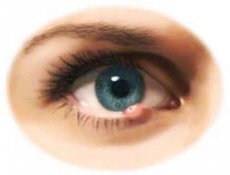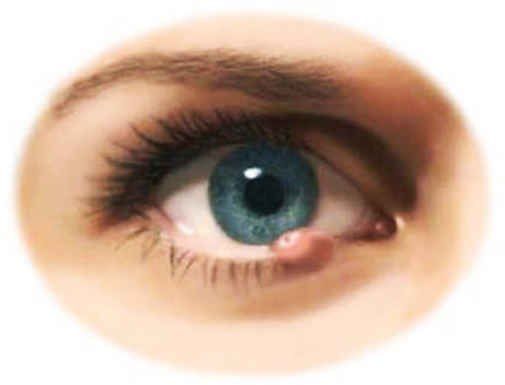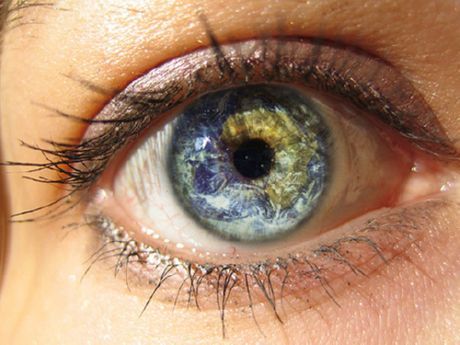Medical expert of the article
New publications
Pain in the eyelid
Last reviewed: 04.07.2025

All iLive content is medically reviewed or fact checked to ensure as much factual accuracy as possible.
We have strict sourcing guidelines and only link to reputable media sites, academic research institutions and, whenever possible, medically peer reviewed studies. Note that the numbers in parentheses ([1], [2], etc.) are clickable links to these studies.
If you feel that any of our content is inaccurate, out-of-date, or otherwise questionable, please select it and press Ctrl + Enter.

Pain in the eyelid may be a sign of eye or eyelid diseases. Pain may be accompanied by swelling of the eyelid, redness or other companions of serious diseases.

 [ 1 ]
[ 1 ]
Structure of the eyelids
To better understand the nature of eyelid pain, you need to know their structure. The eyelids are designed to protect the eyes from foreign objects, rain, sun and dust.
On the edge of each eyelid there are hairs - eyelashes. In the thickest tissue of the eyelids there are glands for secreting lubricant to the lower edge of the eyelids - they are called meibomian glands. The eyelids move with the help of muscles - they rise and fall. When the eyelid hurts, the pain can be localized in any part of it.
Erysipelas of the eyelid
It looks like swelling and redness that look like zigzags. The areas of skin covered by erysipelas are very clearly visible against the background of healthy skin. Erysipelas occurs because the skin is slightly scratched, damaged, perhaps even hit. An infection occurs at the site of inflammation - staphylococcus. Inflammation is accompanied by a high temperature.
Shingles on the eyelid
This disease torments a person due to the herpes virus, which runs along the entire location of the trigeminal nerve or its branches. Shingles looks like a rash on the eyelid in the form of transparent bubbles and swelling, which can go beyond the eye area to half the face.
The person feels ill, nauseous, has a high temperature, weakness, and is bothered by severe pain in the eyelid.
Furuncle on the eyelid
This eyelid disease begins with redness of the eyelid, its swelling, a dense tumor similar to a cone forms on the eyelid. The top of this tumor is filled with pus.
A person's temperature rises, he may have a fever, he may feel nauseous, general weakness, irritability.
Barley on the eyelid
This disease looks like a growth on the edge of the eyelids - upper or lower. This growth resembles a barley grain, which is why it got its name among the people. The eyelid is red, swollen, and very painful.
With this disease, high temperature and fever are possible.
 [ 10 ], [ 11 ], [ 12 ], [ 13 ]
[ 10 ], [ 11 ], [ 12 ], [ 13 ]
Abscess of the eyelid
This disease looks like a dense growth on the eyelid. It becomes swollen, red, if it is the upper eyelid, it falls on the eye. With an abscess of the eyelid, there may be a headache, severe pain in the eyelid itself and a high temperature.
 [ 14 ], [ 15 ], [ 16 ], [ 17 ]
[ 14 ], [ 15 ], [ 16 ], [ 17 ]
Phlegmon of the eyelid
This disease looks like redness of the eyelid, the person is bothered by general weakness, severe pain in the eyelid, body temperature can rise to 38-39 degrees, headache.
The cause of eyelid phlegmon is microbes that promote the formation of pus; an increased risk of phlegmon occurs when a person injures the eyelid.
Phlegmon occupies the eyelid after inflammation of the paranasal sinuses, barley, blepharitis, furuncle on the eyelid. Phlegmon can increase its harmful effect on the eyelid for several days, and then surgery is required because the pain is unbearable. If you open the source of infection on the eyelid, then soon the twitching pain subsides, the eyelid can return to normal. Phlegmon is dangerous because the infection can spread to neighboring areas of the face and to the brain.
 [ 18 ]
[ 18 ]
Acute purulent conjunctivitis
The pain in the eyelid and eye is sharp, strong, as if sand had been poured into the eyes. The conjunctiva of the eye turns sharply red, hurts, and pus comes out of the eyes. This pus dries up and remains on the edges of the eyelids. The causes of conjunctivitis are pathogenic bacteria.
 [ 19 ], [ 20 ], [ 21 ], [ 22 ], [ 23 ]
[ 19 ], [ 20 ], [ 21 ], [ 22 ], [ 23 ]
Orbital phlegmon
This disease manifests itself as redness on the eyelid, swelling, the eyeball becomes bulging, as in Graves' disease. It is impossible to move the whites of the eyes, to look in different directions because of pain. The person is bothered by headache, diplopia, the body temperature is significantly elevated, it is accompanied by chills, fever.
The cause of orbital phlegmon is infections, as well as previous boils, styes, erysipelas, sinusitis, abscesses, eyelid injuries, infections, and foreign bodies getting into the wounds.
Orbital phlegmon is very dangerous for both vision (it can be lost) and human life – this disease can end in death. Since the veins from the eye go towards the brain, it can be infected with the same infection that causes orbital phlegmon.
Phlegmon of the lacrimal sac
In the lower inner corner of the eye, swelling and inflammation appear, the swollen area becomes denser and painful. The skin of the eyelid is red, it is impossible to touch it, but when you touch it, you feel a dense area of skin in the form of an oval in this place.
Phlegmon of the lacrimal sac occurs as a result of inflammation of the eyelid, which does not go away for a long time.
 [ 26 ], [ 27 ], [ 28 ], [ 29 ]
[ 26 ], [ 27 ], [ 28 ], [ 29 ]
Endophthalmitis
This is pus and inflammation of the inner eyelid, and with it the membranes inside the eye. The eyelid and eye hurt. Causes - eye and eyelid diseases, especially infectious processes.
The infection can penetrate the eye membrane and eyelid through the blood even from the internal organs. A person may see almost nothing, the eyelids are swollen and red, the conjunctiva of the eye is also. The cornea of the eye is swollen and inflamed, the vessels of the eye are dilated, bright red, very noticeable. The eye tissue changes its density - it becomes soft. The pain is not so strong at first, and then it can be sharp and unbearable.
 [ 30 ], [ 31 ], [ 32 ], [ 33 ], [ 34 ], [ 35 ], [ 36 ], [ 37 ], [ 38 ], [ 39 ], [ 40 ]
[ 30 ], [ 31 ], [ 32 ], [ 33 ], [ 34 ], [ 35 ], [ 36 ], [ 37 ], [ 38 ], [ 39 ], [ 40 ]
Chalazion (another name is hailstone)
This disease manifests itself as a chronic inflammatory process of the cartilage inside the eye muscle around the above-mentioned meibomian gland. When you touch the eyelid with your hands, it feels like a large pea under your fingers. There is mobile skin above this pea, and in the conjunctiva area there is a greenish spot with strong redness around it.
Not only pain can be a concern, but also purulent discharge, the eyelids are red and swollen, the reddened area can burst and pus will flow out of it.
Corneal ulcer

An ulcer on the cornea of the eye occurs due to its inflammation and purulent infections. The pain is severe immediately. It does not subside, but only intensifies. Tears may actively flow from the eyes, the eye hurts, as if sand was poured into it, the eyelids hurt, and the eyelid may turn inward.
During this period, a person’s vision sharply declines, he stops seeing, and in the light the pain in the eyelid intensifies even more.
The causes of this disease are trauma to the cornea of the eye, even minor ones, previous conjunctivitis, dacryocystitis.
For all diseases that begin with pain in the eyelid, you must definitely consult an ophthalmologist and infectious disease specialist. If eyelid pain is accompanied by other symptoms - fever, swelling, redness - the disease may be serious and cannot be treated without the help of a doctor.

